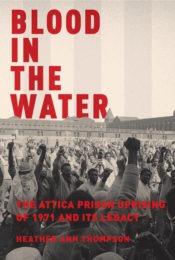Don’t believe the fashionable notion that linear narrative is passé. Heather Ann Thompson’s essential and heart-stopping new book, Blood in the Water, hurtles through the horrific story of the Attica uprising and its consequences like a freight train, all 571 pages. If Charles Dickens were writing nonfiction, this is how it would read.
It’s a sickening story, to this day. An ancient and neglected prison is seized by the inmates and violence and stupidity ensue, culminating in a bloody armed retaking and retaliatory torture and murder. As Dickens knew, truth is more easily absorbed when it appears as particular human experience. Thompson marshals individual acts of brutality, murder, rape, sacrifice, heroism, cowardice, and dishonesty that tell the shameful tale, and she makes you care about it.

Blood in the Water: The Attica Prison Uprising of 1971 and Its Legacy
By Heather Ann Thompson
Pantheon Books 752 pages, $35
She also makes accessible the social and political assumptions that birthed the massacre, and how it eventually changed things, for good and bad. Physical neglect, isolation, and brutality were the prison policies of the day, and even Governor Nelson Rockefeller, an otherwise thoughtful man, had no interest in spending the money or political capital to address the issues. Worse, he authorized the violent suppression of the uprising, in which state bullets killed prisoner and correction officer alike. And then he lied about it.
Thompson lays out Rockefeller’s deceit. “The bottom line, Rockefeller confirmed for Nixon, was that the entire rebellion had been masterminded by African-Americans. ‘The whole thing was led by the blacks,’ he said, and he assured the president that he had sent in the troopers ‘only when they were in the process of murdering the guards.’”
Attica Prison was a monstrosity born of old ideas and bigotry. Its defining characteristic was endemic racism, the old-fashioned Bull Connor violent persecution of African-American men that provoked resistance. There’s a grim inevitability to the events Thompson recounts that leaves almost no room for hopeful “what-ifs.” A system as vicious and violent as Attica Prison eventually devoured itself and all within it. Looking back, no other outcome seems possible.
The legal aftermath was a tissue of lies and cover-ups that continues to this day. The post-massacre investigations are still secret. Some of the most compelling new information Thompson includes was the result of a clerical error that unsealed names and findings previously withheld. Justice was not the goal. The guilty were protected and the innocent persecuted. The families of dead prison guards were euchred and bullied by the State until they rose up and demanded fair compensation. The decision in 1976 by Governor Hugh Carey to pardon everyone—prisoner, correction officer, state policeman alike—closed the book on legal proceedings. Truth was to come, but from scholars and authors, culminating in Thompson and her magisterial book.
Attica’s longer-term consequences are a litany of progress and regression. By and large, the daily brutality and neglect of prison life in New York gave way to improved conditions, including better interactions between prisoners and their families, and an infrastructure of advocates who do what they can to rationalize prison life.
That is not to say our justice system makes any sense. Within two years, Rockefeller had proposed the infamous drug laws that bear his name. They imposed mandatory minimum sentences of 15 years to life for possession of four ounces of drugs, roughly the same as a sentence for second-degree murder.
Inevitably, state prison populations exploded, from around 12,500 at the time of Attica to over 70,000 by 2000. Policies of mass incarceration were Attica’s lingering consequence. The relative good news is that the repeal of the worst of the Rockefeller drug laws and other attacks on mass incarceration have significantly lowered the number of New York prisoners to around 50,000.
Thompson’s book is a wonder. Her moral perspective admits both prison guard and prisoner to humane understanding. Her prose is lucid. Her eye for detail, applied to everything from the horror of wounds to the rape of prisoners by prisoners, is impeccable. She captures the personal courage of mediators Tom Wicker of The New York Times, Assemblyman Arthur Eve, and civil rights lawyer Clarence Jones who entered the prison yard when it was still controlled by armed and suspicious inmates and their hostages.
I served for 20 years in the New York State Legislature with Arthur Eve. He is an impassioned, empathetic, and difficult man. Once, during a late night session, he began to tell a few of us some of the harrowing things he saw in those four days. He told us what he felt entering the prison when white guards were yelling “get your nigger ass out of here” (an episode recounted in the book). He told us about an emotional parting from a prisoner known as Big Black, when the armed retaking of the prison was imminent. He cried, quietly. So did we. But only upon finishing Blood in the Water did I understand the depth of his grief—for the loss of life, loss of human dignity, loss of hope, and for his own felt failure to prevent the apocalypse at Attica.
Blood in the Water is more than a good read. It’s a cautionary tale. Forty-five years later, we are left with a prison system that to a degree is less brutal, less overtly racist, and less likely to explode. Yet we suffer still from the institutional racism, economic inequality, and failed punishment modalities that once returned us murder, mayhem, and injustice. Progress requires accountability, and in giving us Blood in the Water, Heather Ann Thompson has done justice to the people and events of September, 1971. Finally.
Richard Brodsky is a former Member of the New York State Assembly. He is now an attorney and a Senior Fellow at Demos Action and NYU’s Wagner School. He has a regular blog on Huffington Post, and a column in the Albany Times Union.







0 Comments